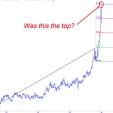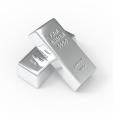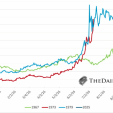Best-Case Scenario Has A Worst-Case Twist
So, I did say my “worst-case scenario” did not seem like the most likely scenario to play out from the G-20 summit. Now we know my “best-case scenario” and most likely scenario is the one Trump and Xi have chosen, but what does that mean for the month of July?
Here was the best-case scenario
Xi and Trump agree to come out of their meeting sounding like there is hope for a future agreement soon (albeit with nothing specific that has been agreed upon). We all know there is no chance they come out with a deal. So, the best hope is they come out with Trump talking (again) like a deal is imminent and, therefore, he’ll hold off on his tariff increases a little longer. The market feels relief and breaks resoundingly through its eighteen-month ceiling. The remaining indices that have not cleared through their upper barrier manage also to poke through to a new high and manage to hold … for a little while.
“Market Mania Bets The Cash Registers Go Xi Ching! “
In that scenario, I said the next step for the market would likely be that the remaining stock indices that have not pushed past their own previous peaks would now punch through. By that (and I probably should have been clearer originally) I meant those indices like the Dow that were very close to breaking past their old heights, not those like the Russel 2000 and NYSE that are still deep in their bearish zone.
Here sits the Dow trapped at its old summit of nine months ago:
It has remained trapped at this height for a year and a half:
With the Xi summit being something Trump can trumpet about for one or two toots, I would not be surprised to see the Dow break through its past ceiling due to the market’s relief that the G-20 did not result in tariff escalation that had been threatened. However, I also gave a major caveat in my best-case scenario, so hang on:
Then what? All is roses, right? Well, the market has clearly already priced in a trade agreement being reached — also, with apparently 100% certainty — so hope won’t buy a lot more headroom at the market’s top because it’s the same hope that investors have been spending all along. Buybacks are now temporarily frozen out. Even Crazy Cramer is saying the economy looks worse than what the market thinks, He has even stated that, with all of his many executive contacts, he knows of no company that is not going to come in with lower earnings than last quarter. Economic data has been trending down. Forward projections are already being written ahead of any Chinese trade deal, so they won’t likely go up just because, once again, the Trumpet blares an announcement of a trade deal on the horizon. (The market will go up if Trump makes such a proclamation (again), but corporate reports aren’t going to change because of it.)
That means the market likely gets a boost as it raises a cup of cheer to tariff relief (not relief of tariffs already in place but relief from the fear of more and higher tariffs for the moment). That will be short-lived.
A pause in [tariff] escalation in the near-term could still lead to additional tariffs later this year. In the two analogous leader-to-leader meetings noted earlier, President Trump agreed to postpone further tariffs. However, in both cases, this détente was only temporary, as the White House eventually imposed additional tariffs on imports from China [because] … financial markets do not appear to be an obstacle to tariff escalation… The last two times President Trump seriously escalated trade tensions with China, the S&P 500 was near record highs…. We would expect that the President now views tariff threats as not only a successful negotiating tactic following the immigration agreement with Mexico but also a useful tool in pressing for looser monetary policy. If so, this suggests that the White House will at least threaten further tariff increases and might follow through with some of them….
If history is any predictor of the future (based on its patterns, which it sometimes is), then we have reason to think it won’t be long and Trump will be back to threatening higher tariffs on China. We also could find any boost to the market being very short if China (as has happened in the past) comes out of the meeting saying later that things were not as rosy as Trump announced.
Mostly, however, what we have in July is the real economy to face, more than the fake market. Though trade tariffs are temporarily somewhat sidelined with the stock market having received what it wanted, the economy isn’t going to change for the positive one bit because of that.
The stock market, in the best case scenario, stalls out at its new top because there is no more good news in the pipeline right now. The Fed’s fully presumed rate increase still lies a month away, so the market is going to be running on fumes in the face of falling earnings and falling projections for the upcoming quarter. Trump badly wants rate reductions from the Fed and may see uncertainty over a trade agreement as a way to press Powell to move on that, given that trade uncertainty seems to be what tipped him in the direction of talking about loosening the financial reins in June. Trump will want to press him from talk to action, and that’s a hard press.
“Market Mania Bets The Cash Registers Go Xi Ching! “
We’re not going to bolt forward into any actual trade agreement when Trump want’s to pressure Powell into rate cuts. Meanwhile, the economy is deteriorating rapidly. Unemployment claims again last week notched slightly upward. Consumer sentiment went downward, etc.
GDP will be coming in lower because lower earnings everywhere almost certainly go with lower GDP…. The market is clearly going to be bucking a lot of headwinds throughout the July corporate reporting season, and the fumes of Chinese trade hopes are not likely to sustain much lift when they are already priced in. So, in the best-case scenario, the market rises briefly, then struggles to hold against all these winds to await the Fed’s actions.
So, that is where the stock market will be bouncing around in July, struggling to buck economic headwinds after a spurt of relief-ecstasy over the trade war as investors wait with bated breath to hear from Powell that he is cutting interest rates. No one should make much of the market breaking through its past ceiling a little bit, given that all past attempts to rise past this level failed to hold. The S&P each time has notched a little higher, but then immediately and sometimes spectacularly failed:
Maybe the S&P will even manage to do a hail-Mary to the bull’s long-forecast 3,000 mark, but I wouldn’t hold out hopes that it will hold above its very gradual upward trend line for long. I’m not saying that based on any chart forecasting, but just based on the fact that it hasn’t managed that in a year and a half of trying, and there is not likely much good economic news in store. Lack of good economic news, however, may give it hope that the Fed will start doling out more cheap or even free money.
That means the market’s major moves will all hang now on what the Fed feeds the market at the end of the month … until the economy crashes so bad that nothing Powell can do will save it. (See previous articles for that long argument.) Powell is powerless to stop a recession, though he can manipulate markets quite well.
Best-case scenario does not eliminate all of the worst-case scenario
We’ll still see elements of my worst-case scenario playing out because the reprieve from Trump’s G-20 summit with Xi will be short-lived as indicated above.
The market has a long way to fall from precarious heights with a lot of bad news likely in the pipeline ready to help stuff it down and no buybacks available for a month to prop up share prices. GDP for the second quarter comes in with a sharp decline … and we have to wait until the end of July for the Fed to give the boost that has already been fully priced in by the market. The mere hope of that boost probably cannot do much more fueling than it has already done; but there is a lot of room for the market to crash if that hope is miscalculated and doesn’t come about at the end of July.
Most importantly, the Fed never said it is likely to lower interest in July. Not even close! It actually said it did not anticipate a rate drop until 2020! It merely hinted it was open to rate drops and only if merited (MEANING only if the economy is sinking). Yet, the market is assuming it will bemerited as early as July, 2019. That means, underneath all the market mania, the market must be schizophrenically anticipating news will be so bad over the course of the next month that it will kick the Fed in the butt and get them to drop their pants (or at least their interest).
Under my worst-case scenario I also said,
I think Trump will likely try to use trade uncertainty to push Powell into making a rate cut in July, given that Powell has now indicated some willingness but is far from having said the Fed will do anything soon. After all, if Trump gets Powell to cut interest rates, he will feel he has proven to the world that Powell screwed up just as Trump said by raising rates as long as he did.
I think we all can agree that Trump will do all he can to get Powell to do that under any scenario. We also know Trump loves being unpredictable all the time and loves surprises, so I wouldn’t be surprised if he tries to walk his talk both ways by continuing his threatening talk about tariffs in order to keep both Xi and Powell on edge. Talk may be light for a day or two in order to get some market pop out of the G-20 meeting, but thereafter, I think Trump will want to hold Xi’s and Powell’s feet to the fire. The cost to that is an economy in turmoil because businesses have no idea what to plan for; capital investment stays on the fence; consumers don’t know what to anticipate.
Worse still, if the Fed doesn’t give its rate drop at the end of July, as it has indicated it will not, where is the bottom, given that the market is priced for 3-4 rate cuts and 100% likelihood of a quick end to the trade war?
With that deep risk noted, I have said and still believe the Fed will drop rates in July because things will be so perilous by the end of July that it will have no choice, and Trump will do all he can to box Powell into that corner. In fact, I think it will be clear by then that the Fed already waited too long.
I think the market has some turmoil ahead of it after its first fits of relief as it waits out the Fed’s response. I won’t be surprised if the Fed cuts rates in the end either, but it will not cut solely because of tariff concerns but because of how transparently the economy is headed south at that point. The market may rise again because of the Fed’s cuts, but these cuts happen in an entirely different environment and are not the good news the market has been conditioned to believe all cuts are over the past ten years.
By the end of July, the market may already be well on its way toward that unfathomable bottom, and the Fed’s rate cut will be desperate salvation at that point.
This next rate cut will only mean the Fed has conceded that its recovery has failed and the economy is back in peril.
A market crash could happen even in the best-case scenario if corporate reports are bad enough late next month to indicate recession is at our doorstep and if GDP falls while buybacks are halted while Trump tries to create more uncertainty about a trade deal because he is currently confident in the market and wants to pressure Powell.
In other words, after a burst of renewed and ill-conceived hope, the market will have more than the usual wall of worry to climb. If the Fed fails it, I would expect an all-out panic because the bulls are vesting all their hope over the next month in the Fed. Their hope will not be based on economic data, other than on the inverse hope that bad economic data assures a Fed rate cut; but the removal of trade-war pressures makes it less likely the Fed will cut in July. Imagine what would happen to the market if the Fed failed to cut interest rates and then the Trump Tariff War heated back up!
Regardless, even if the Fed does cut and gives the bulls another ego boost …
While Powell’s dovishness has been enough to revive financial markets, expecting monetary policy to do the same for the economy is asking too much.
One way or another …
At the end of the day, the economy wins the argument, and the economy is going down. It takes the Fed years to turn the economy around with the help of fiscal stimulus, and both are tapped out now anyway. So, we are coming to that summer inflection point that I have been warning you about all year. (Remember when it happens that you heard that timing here first.)
The manic market is hoping for two mutually exclusive things — a China trade deal that will take away the earnings problems that are now endemic and the lack of China trade deal to press the Fed to preemptively lower interest. It is even irrationally refusing to recognize the historic fact that lowering interest rates when the economy is supposedly in recovery only happens when the Fed believes its recovery is about to fail, and no stock market has ever done well as we are plunging into recession
That’s a lot of crazy, and crazy doesn’t end well.
A sudden move to lowering rates after a year or more of raising them means without fail recession is coming.
In the Great Depression, the problem was drought. In this one, it’s a flood … of bad news.

With lots of bad economic news in the pipeline — mid-west farmers on top of it all — and a stock market that cares only about anything that means more free Fed funds, it’s impossible to know how long the market can climb this wall of worry. Will it just endlessly take all of the bad news as proof of hope for free Fed funds, or will it eventually become exhausted from so much bad news? It is impossible, that is, unless the Fed fails to deliver on the demanded rate cut, in which case there is no question the market throws a tantrum and fails. If you are a market investor, you’re going to be betting everything in July on what the Fed does.
The point here? Either way, the economy fails; and already-fully-priced-in rate cuts won’t give much lift beyond the end of July in a diminishing economy if the Fed comes through, but failed rate cuts pull the rug out from under everything. The market is priced to perfection with little upside potential and a lot of downside. So, roll big for the last little hurrah, or … duck and cover.

*********


















